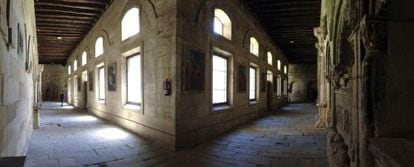Cathedral claim breathes life into cloister debate
Medieval expert says the Romanesque gallery discovered on a private Catalan estate dates back to the 12th century and comes from Salamanca


A year after the regional government of Catalonia decided that what appeared to be a portion of a 12th-century Romanesque cloister in the garden of a private house in the town of Palamós was not the genuine article, an expert in medieval architecture is now saying that it is the real deal, and comes from Salamanca cathedral.
Gerardo Boto, a lecturer in medieval art history at the University of Girona, on Thursday told a conference on the subject of 10th-18th century Mediterranean cloisters in Lisbon that the cloister is entirely from the 12th century, and not, as the Catalan regional government's experts had said, a recreation put together in the 1930s, using one or two original pieces of carved stone.
The intricately carved sandstone cloister was first brought to public attention by Boto last year. Since 1958 it has provided an elegant backdrop to a swimming pool in the garden of a 200-year-old farmhouse, Mas del Vent, owned by wealthy German philanthropist Kurt Engelhorn.
Further research suggested it was put together in 1931 in Madrid by a private collector, Julián Ortiz, after an antiques dealer named Ignacio Martínez had bought the stones from an unknown source. It was then meant to be sold to an American buyer but the deal fell through. In 1958 the cloister traveled to Palamós after it was purchased by the Engelhorn family.
In the rush to produce a report before the August holidays last year, a group of experts comprising four restorers, three archaeologist-architects, two geologists and an art historian appointed by the Catalan regional government left many questions unanswered. But Boto was not invited to contribute. He is a specialist in Castilian Romanesque sculpture and the author of seminal books on the subject as well as a dissertation on the monastery of Silos, which he has compared with the Palamós cloister.

Boto's presentation in Lisbon last week was initially about the cloister in Salamanca's first cathedral, built in the late 12th century, which was badly damaged in the earthquake that destroyed much of Lisbon in 1755, and subsequently rebuilt in the Baroque style.
Boto believes that after efforts were made to repair the cloister's pillars in 1770, in 1783 the cathedral authorities ordered it to be dismantled, but not demolished. He says the records show that the majority of the stones were in good condition and that the cloister was dismantled "with the utmost care" so that it could be put back together again. He says this level of appreciation toward Romanesque art was "unknown" in the Baroque 18th century.
But two years later, in 1785, it was decided to build a new cloister. Taking advantage of the new construction work, the width of the cloister was widened by "two feet," with the result that the new arches were smaller than the 12th-century originals. The old stones, which were numbered as they were dismantled, were stored, "and not thrown away," says Boto.
Boto supports his argument with detailed technical explanations regarding the measurements of the construction, saying that the best indicator of the original construction's size are the four beams still kept in the cathedral museum and considered part of the original 12th-century roof of the cloister.
He says the height of the cloister can be gauged "by the marks that are still on the gallery's walls. Boto says that in April, ground-penetrating radar was used to investigate what lies beneath the current cloister. The images showed the remains of walls and solid elements in the four passages, as well as reinforcing of the corner walls. Last week the cathedral authorized further exploration "to confirm once and for all the ground-penetrating radar evidence."
A stroll through time
- 1931. A Madrid antiques dealer, Ignacio Martínez, purchases the cloister. No information about its origins is provided. The monument is put together on an empty plot in the suburban Madrid district of Ciudad Lineal. The land is owned by a marchioness who is a friend of Martínez. The woman asks the antiques dealer Julián Ortiz Fernández to restore and care for it.
- 1958. Hans Engelhorn, a relative of today's owner, the Swiss national Kurt Engelhorn, purchases the cloister and transfers it to Palamós (Girona).
- 1967. The owners order a report based on photos from the Metropolitan Museum of New York, which sheds doubt on its authenticity.
- 2010. The French edition of interior design magazine AD devotes a story to the Mas del Vent estate. The same year, the Friends of the Romanesque association presents several petitions to the Catalan regional government to allow experts to assess the cloister, but the government refuses to comment.
- May 2012. A presentation by Gerardo Boto, a professor of medieval art, starts renewed interest.
- June 5, 2012 . EL PAÍS runs its first story about the cloister, and for the first time the monument is opened up both to experts and the media.
- June 7. A panel of experts appointed by the regional government is finally allowed to inspect the cloister.
- July 19-30, 2012. The Catalan government calls together a panel of experts, who disagree over the final report on the cloister's origins. The regional government releases its conclusions, confirming that it contains elements from the 12th century but the rest was built in the early 20th century.
- November 2012. Restorer Pilar Giráldez, a member of the panel, says: "The samples leave no doubt as to the authenticity and centuries-old age of the stones."
- June 20, 2013. Boto tells a conference that the cloister is from the 12th century, and was originally part of Salamanca cathedral.
Boto has also discovered a document dating from 1923 in which cathedral authorities give permission "to sell the stones extracted from the garden of the old cathedral cloister," although no buyers were found. He argues that the most logical use of the stones would be for repair work to the cathedral. But he says the architects responsible for such work at that time in fact removed many decorative elements from the stonework.
Little is known about the cloister, and no mention of it has been found before 1940, by which time, says Boto, it had been removed from Salamanca and rebuilt in the garden of a house in the outskirts of Madrid.
"There exists a collection of cloistered Romanesque galleries made from stone quarried in Salamanca with the same measurements, with reinforced corners, along with capitals in the Salamanca design and others that copy the 'medieval style' of Silos, and that show signs of having been exposed to the weather for centuries," Boto told his audience last week. "This is the missing cloister of Mas del Vent: old Romanesque galleries both in terms of their overall profile as well as in the elements used to construct them," he said.
He then went on to explain that the stones are numbered, and that the markings used to identify them correspond to the style used in the late 18th century in Salamanca cathedral.
Boto says he is sure the cloister at Mas del Vent does not include any extra stones not used when it was in Madrid. "The structure in Palamós has the same measurements as that in Madrid. The difference is the one in Palamós has been slightly set into the ground, while in Madrid it was raised up, as the Ortiz family photos show." He adds that trident-shaped marks in the stones, for which the Catalan government's experts had no explanation, were created "in 1783 when the stones were being numbered, and to help with separating them from the cement holding them together, which is why they do not correspond to any medieval building methods."
He insists that any "modifications, alterations, additions, or other marks were added during the transfer and reconstruction in Madrid," adding that it is remarkable that the dimensions of the construction were maintained. "It is astonishing that the measurements are the same as those in Salamanca and Palamós."
For Boto, the fact that the floor measurements of the cloister are the same as the cloister originally in Salamanca is the final proof. "This certifies their origin. It was not possible to know which measurements to fake because there was no need to do so. This is irrefutable evidence that it is authentic."
Boto says anybody seeking to disprove his theory would have to explain how it was possible, in 1930, to carve 42 capitals, each measuring 45x90x40 centimeters, "adapting them to the dimensions of the two that existed." Boto originally conjectured that the cloister could have come from Santo Domingo de Silos, a Benedictine monastery in Burgos province. The monastery is one of the best examples of Romanesque architecture in Spain and its cloister, a secluded quadrangle flanked by archways on its inner side, is one of the most superbly preserved.
Boto first stumbled across the cloister in the French design magazine AD in 2010 and started an investigation that involved carefully analyzing the photos in the magazine and checking Google Earth to get an idea of its size. He was unable to gain access to the estate until he unveiled his theory at an art conference, sparking media attention and prompting the owners to allow access to the site.
The Engelhorn family says it has never felt the need to determine the authenticity of the cloister, but has a letter from a Metropolitan Museum of New York curator calling it a fake. Now, the Engelhorns say that if the cloister is genuine, they will allow visitors in to see it.
Two members of the expert panel, geologist Marius Vendrell and restorer Pilar Giráldez, came to the same conclusion as Boto, saying the wear and tear on the stones indicates they are from the 12th century, and that this can be seen in the photos of the reconstruction in the 1930s, when the regional government says the cloister was built.
The expert committee was not able to establish the origin of the first stones, although they said they must have belonged to a cathedral or a major monastery. They also said they were unable to determine the original religious construction from where the authentic pieces originate. They did assert that the stones were obtained from the quarry of Villamayor, in Salamanca.
Eduard Riu, the head of the regional government of Catalonia's Architectural Heritage Service, who headed the panel, also believes the cloister is authentic: "A cloister of these dimensions and this spectacular could only be in a cathedral or a great monastery."










































